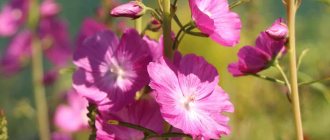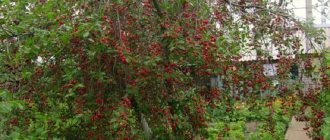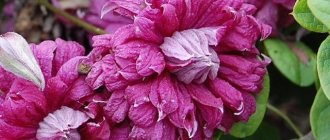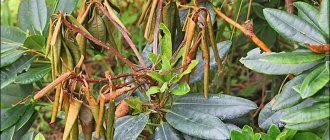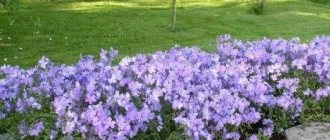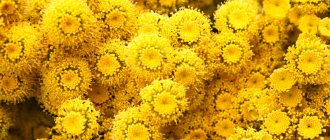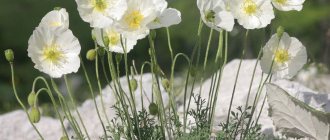Detailed description
Rhododendron belongs to the Heather family. In total, there are almost 3000 of its varieties, with Roseum Elegance being one of its brightest species. In nature there are creeping shrubs and tall trees (30 meters).
Leaves
The hemispherical tall bush (3 meters) forms a very wide crown, almost 3.5 meters in diameter. This elegant plant has medium-sized leaves, their shape is elliptical, the color is dark green, but at first reddish-brown. The structure is dense, the surface is shiny.
Flowers
Beautiful pink flowers with reddish splashes grow quite large in size, they are 7 centimeters in diameter. In shape they resemble a wide funnel, the edges of the petals are slightly wavy. Roseum Elegans rhododendron flowers are formed into dense inflorescences, collecting 15 pieces in each.
Bark
The color of the bark on the trunk and branches of the evergreen shrub is dark green.
Root system
The plant has a superficial type of root mass.
Fetus
The rhododendron roseum elegans shrub produces seed pods.
Temperature
The ornamental plant tolerates frosts down to -32 degrees quite painlessly. He is not afraid of heat of +30 degrees. But for normal growth and development, it needs a temperature range from -15 degrees to +20 degrees.
Prevention of various problems
Rhododendron reacts worst to violations of agricultural practices: dense planting, lack of watering and preventive treatments against pests and diseases. Curling leaves are a signal that the bush needs feeding. With minimal effort, pink elegant rhododendron will increase in size every year, but can quickly die due to leaf fungi or drought without water.
It is still a real success to find such a rarity as rhododendron in an ordinary garden. Meanwhile, the beautiful flowers of Roseum Elegance are available even to residents of the Moscow region and Leningrad region.
*Prices are as of August 2021.
Landing
To obtain the desired result, rhododendron Roseum Elegance must initially create comfortable conditions for rooting and vegetation.
See also
Planting, growing and caring for garden begonia in open groundRead
Selecting a location
Considering that the ornamental shrub reaches a height of three meters and prefers to grow in partial shade, choosing a clearing for planting it is on the north side of the garden. Rhododendron Roseum Elegance looks especially impressive near a residential building or along a fence; it can also be used as a hedge or to decorate an alley. But, if possible, then it should be planted near a reservoir.
Soil preparation
For rhododendron Roseum Elegance, the optimal soil is a soil with a slightly acidic environment. Coniferous litter has a beneficial effect on the underground part of the evergreen shrub.
Pit preparation and planting scheme
It is recommended to plant rhododendron seedlings Roseum Elegance in May-April. If you plan to plant several plants, then you should dig holes at a distance of two meters. The size of the hole should be twice the size of the root system of the bush. The soil is required to be permeable and fertile, consisting of peat, leaf soil and pine needles.
Planting algorithm:
- A drainage cushion made of expanded clay should be placed in the bottom of the hole, then a layer of soil mixture.
- Place a rhododendron seedling Roseum Elegance in the center of the hole and spread its roots to the sides.
- Then sprinkle with soil and carefully compact to eliminate voids.
- The bush is watered and mulched on top with peat, pine bark or pine bedding.
Rhododendron Roseum Elegans: description, planting and care, reviews
Rhododendron is a representative of the Heather family, divided into species, which include several varieties and hybrids, differing in the color of the inflorescences and the height of the bush. Rhododendron Roseum Elegans was bred in England and included in the Katevba group, the originator of the variety is Anthony Waterer. Culture was created for use in landscape design.
Description of the hybrid rhododendron Roseum Elegance
The decorative evergreen shrub Rhododendron Roseum elegans grows in Japan, the Northern Hemisphere. In Ukraine it is known as Chervona rue.
Rhododendron is found in the tundra, mountainous regions, and grows in groups near wetlands. Rhododendron Roseum Elegans (pictured) is a spreading shrub that grows up to 3 m in height, with a crown volume of 3.5 m.
It has a decorative appearance throughout the year.
During the formation of the young crown, the color of rhododendron leaves is dark red, changing to green as it grows. The vegetation of rhododendron is slow, the annual growth is up to 15 cm.
The main increase is observed in the first 5 years, then the increase decreases, reaching the end point at 7 years. At this age, the plant is considered mature.
Outwardly, it is similar to rhododendron Roseum Pontius, but these are different types of crops, differing in the shape of the bush and the color of the inflorescences.
External characteristics of rhododendron Roseum Elegance:
- The bush is branched, widely spreading, rounded in shape, closed at the bottom. The branches are of medium thickness, light green, smooth. Young shoots are a shade lighter than the skeletal branches.
- The root system of the large plant is fibrous, located close to the soil surface, the root circle is wide.
- The leathery leaves are opposite, in the form of an elongated narrow oval, the surface is glossy. Young leaves are dark red, after full formation they acquire a rich green color. Plate length – 9-10 cm, width – 7 cm.
- The flowers have the appearance of a wide funnel, bright pink with dark splashes at the base, diameter - 8 cm, slightly wavy edges, pink-violet stamens. Collected in dense round inflorescences of 20 pieces.
- The fruit is a capsule with small black seeds.
Important! The flowers of rhododendron Roseum Elegance are completely odorless.
Roseum Elegance blooms in June and lasts about 20 days. Flowering is intense, the bush is completely covered with flowers. Rhododendron is used in design as a single plant and as a hedge. Create a composition with coniferous ornamental trees and shrubs.
Rhododendron Roseum Elegans does not tolerate open areas well; the culture is not drought-resistant, so burns on the inflorescences and leaves are possible with excess ultraviolet radiation. If the plant is planted in an area without shade, constant watering and sprinkling is necessary.
Winter hardiness of rhododendron Roseum Elegance
The variety Roseum Elegance is the most frost-resistant representative of the crop. Without additional shelter it overwinters at -32 0C. It resists temperature changes well.
During spring thaws, sap flow begins and a sharp drop in temperature, for example, to -8 0C causes the sap to freeze; this process is not terrible for rhododendron.
After defrosting, the increased volume of juice does not tear the bark, so the wood structure is not destroyed. The plant is not damaged, the growing season continues as usual.
According to the description of rhododendron, Roseum Elegance belongs to frost resistance zone 3.4. The crop is grown in Eastern Siberia and the Urals (zone No. 3). The plant feels comfortable in Central Russia, the Moscow region, and St. Petersburg (zone No. 4). Suitable for designing plots in central Russia.
Conditions for growing rhododendron Roseum Elegans
Despite the fact that rhododendron Roseum Elegans is a crop with low drought resistance, the shrub does not tolerate waterlogging of the soil. For planting, choose loose, light, fertile soils with satisfactory drainage.
In their natural environment, Heathers grow in wetlands, but hybrids do not respond well to close groundwater. An acidic soil composition is suitable for rhododendron. The plant feels comfortable under the canopy of coniferous trees. An open sunny area is not suitable for the plant, so the south side is not considered for planting.
The plant is frost-resistant, but does not tolerate exposure to north winds. According to reviews from gardeners, the best option for the hybrid rhododendron Roseum Elegance would be the north side behind the wall of the building.
This planting will eliminate drafts and direct sunlight. To maintain the necessary moisture, the root circle is mulched every spring. To preserve the decorative appearance of the bush, the inflorescences are removed after flowering.
Planting and caring for rhododendron Roseum Elegance
Hybrid Roseum Elegance tolerates transplantation well and takes root quickly. Due to their frost resistance, rhododendron varieties are grown in regions with cold winters, so planting work is carried out only in the spring. The standard agricultural technology for the crop consists of watering, timely fertilizing and preparing the plant for winter.
Selection and preparation of a landing site
The shrub is planted in partial shade on the north side; rhododendron feels comfortable near bodies of water, but on the condition that the soil is not waterlogged. A week before planting, prepare the site:
- Dig up and remove weed roots.
- Prepare wide but shallow planting holes; if planting is done in a line, the interval between holes is 2 m.
- Drainage is placed at the bottom, and acidic peat mixed with oak leaves is placed on top.
Attention! When planting and subsequent care, wood ash and manure are not used.
Before placing it in a permanent place, the remaining soil is completely removed from the root system of the rhododendron planting material. Place the seedling in a 5% manganese solution, then in a growth stimulator.
Before planting, check the condition of the root and, if necessary, remove damaged areas.
If the planting material is grown independently, it is planted at the age of one year; two-year-old seedlings are purchased from the nursery.
Rules for planting rhododendron Roseum Elegance
A concentrated clay solution is first prepared, and the root is dipped into it immediately before planting. Algorithm of actions:
- A stake is driven into the center of the hole to secure the seedling.
- Carefully distribute the roots along the bottom of the recess.
- Cover the top with a mixture of sand and peat and compact the soil.
- Fix the seedling to the support and water it.
After planting, mulch the root circle with needles or last year's leaves. Compost is not recommended.
Watering and fertilizing
The first feeding is given to the shrub in the spring before flowering. Use special fertilizers for rhododendrons. After flowering, phosphorus fertilizers are applied. Organics are used to a minimum.
Watering is oriented towards seasonal precipitation; two waterings per week are sufficient for the plant. In dry weather, sprinkling is carried out at night.
If air humidity is low, the tops of the leaves dry out, sprinkling is carried out every day.
Trimming
Radical pruning of rhododendron Roseum Elegance is carried out in early August. It is used to form the crown and is a protection against damage to young branches by the mass of snow. Annual shoots are cut to 1/3 of the main length. Remove faded inflorescences. In early spring, dry fragments are removed and the bushes are sanitized.
Preparing for winter
Hybrid Roseum Elegans is a frost-resistant plant. Before wintering, adult shrubs are given water-recharging watering and the root circle is mulched with a layer of mulch (15 cm). For young seedlings, shelter for the winter is important:
- The branches are carefully attached to the main trunk and fixed.
- The top is wrapped with any material that does not allow moisture to pass through.
- Mulching.
- Cover with spruce branches.
If the seedling is not tall, after mulching, install arcs, stretch the film, cover the top with leaves or coniferous branches, and cover the structure with snow in winter.
Reproduction
Hybrid rhododendron Roseum Elegans reproduces vegetatively and generatively. Propagation by seeds is rarely used. The growing season until the first flowering is too long.
The advantage of this method is the large amount of planting material. To obtain seedlings, seeds are sown in a container with a nutrient substrate and covered with film on top.
After germination, the young shoots are taken into separate containers and left in a shaded place.
Important! Seedlings can be placed on the site only after one year in the spring.
A rhododendron grown from seeds will not bloom until it is six years old. The most effective and fastest method is vegetative. Cuttings are carried out in June according to the following scheme:
- Cut material from the tops of two-year-old shoots to a length of 10 cm.
- The cut is made obliquely, the lower leaves are removed, and the cuttings are placed in a growth stimulator for 2 hours.
- Planted in a mini-greenhouse, maintaining constant air and soil humidity.
- By autumn, the rhododendron should take root; it is transplanted into a container and brought into a room with a temperature no higher than +5 0C for the winter.
In the spring they are placed in a permanent place. Rhododendron Roseum Elegans tolerates transplantation well and quickly takes root in a new area. The crop can be propagated using layering.
To obtain planting material, bend the lower branch, fix it to the soil surface, and cover it with earth. Work is carried out in the spring before sap flow. The cuttings are watered throughout the season.
Next spring the material is ready for division and replanting.
Diseases and pests
Roseum elegans rarely gets sick and is damaged by pests. The appearance of a fungal infection can cause moisture to accumulate in the soil. With high humidity and a sharp drop in temperature, chlorosis or leaf spotting develops, in which case treatment with Bordeaux mixture is necessary. If there is a deficiency of nutrients, the leaves curl and the plant needs to be fed.
Among the garden pests, the rhododendron bug parasitizes the shrub; it is eliminated with Diazonin. The mealybug feeds on the sap of the leaves, covering them with a dense white coating. Karbofos is used in pest control. Spider mites are less common; the bush is treated with Agrovertin.
Conclusion
Rhododendron Roseum Elegance belongs to the Katevba variety. This is a tall spreading shrub with a decorative appearance. During the flowering period, the crown is completely covered with spherical bright pink inflorescences. The culture is frost-resistant, evergreen, and is widely used for landscape design in regions with temperate climates.
Reviews of rhododendron Roseum Elegance
Rimma Sazonova, 40 years old, Leningrad region
On the Roseum plot, Elegance is planted along with other varieties of rhododendron on both sides along the length of the garden path. I took varieties for the alley with different flowering periods and colors of inflorescences.
Shrubs bloom from May to August. Roseum Elegance dominates the planting; I gave preference to the hybrid for its abundant flowering and frost resistance.
I have had this crop for more than five years, and there have never been any pests or diseases on the bushes.
Alexey Romanov, 35 years old, Moscow region
I purchased Rhododendron Roseum Elegance from a nursery and planted 5 seedlings on the shore of an artificial pond on the site.
The plant needs enough air and soil humidity; according to its biological description, the crop grows slowly, but in four years it has grown to 2 m.
The plant blooms in mid-June in a solid pink mass and remains in this state until July. The big advantage of the hybrid is the complete absence of the smell characteristic of rhododendron.
Source: https://fermilon.ru/sad-i-ogorod/dekorativnye-kustarniki/rododendron-rozeum-elegans-opisanie-zimostoykost-posadka-foto.html
Care
Caring for rhododendron Roseum Elegance is not difficult, the main thing is to moisten the soil in a timely manner, add nutrients and prune.
Watering
Taking into account the tall growth of rhododendron, the optimal volume of water per planting is 30-50 liters. From time to time, the bush should be watered with acidified liquid, using citric acid or lemon juice for this purpose. The sprinkling method has a positive effect on it.
Top dressing
It is recommended to alternately apply fertilizers of organic origin and mineral complexes under the bush.
Trimming
To maintain the compact size of the crown, given its spreading nature, it is necessary to prune. It is best to do this at the end of the flowering phase.
Transfer
If necessary, rhododendron Roseum Elegance can be replanted, but work should be planned for spring or summer. Thanks to the shallow root system, it is quite easy to remove the bush from the ground.
Preparing for winter
Despite the high level of winter hardiness, it is still worth covering the shrub during the frosty period. Spunbond and lutrasil are used for these purposes. The material will perfectly protect the branches from freezing.
Protection from diseases and pests
If you adhere to the correct agricultural technology, then the Roseum Elegance rhododendron is practically not in danger. Only when there is excessive moisture in the soil, increased acidity, or the presence of sunburn, the shrub begins to hurt and is affected by fungal diseases. They can only be controlled with fungicidal agents.
If the rhododendron suffers from an invasion of snails and slugs, then they must be removed manually. And against pests such as spider mites, rhododendron bugs, flies and mealybugs, it is effective to use insecticides that do not harm beneficial insects (bees).
See also
Description of 20 varieties and types of Chionodox, planting and care in open groundRead
Removing faded inflorescences
To prevent inflorescences that have already bloomed from spoiling the appearance of the shrub, they should be removed.
Diseases and pests
Roseum Elegans diseases include:
- necrosis (due to a sharp change in temperature);
- fungal diseases (such as mosaic, spotting, chlorosis);
- leaf deformation (due to lack of fertilizers).
Gardeners fight fungi by spraying with Bordeaux mixture. A solution (1%) is used to irrigate in cool, dry weather during the period of active plant development. In spring and autumn, preventive watering is done with 3% liquid. All treatments should not be more than three per season. For 10 m², use 1.5 liters of the finished mixture.
Did you know? You can water rhododendrons with water and lemon juice to acidify the soil.
Pests of the crop are:
- rhododendron bug (the drug “Diazinon” in granules is suitable against it - read the instructions on the product packaging);
- mealybug (control - three times treatment with Karbofos at intervals of a week or two);
- spider mite (Agrovertina emulsion in ampoules of 5 ml per 5 liters of water helps).
To prevent rotting, which makes rhododendron susceptible to fungal diseases, it is important to water the plant abundantly, regularly, but only so that there is no stagnation of liquid . Pre-created drainage usually helps to avoid this. If the crop is affected by fungi, it can only be saved with fungicides. Otherwise, especially if the damage is extensive, the bushes should be destroyed and the soil treated. Shrubs love to be attacked by slugs, but they don't cause too much of a problem and it's easy to remove them yourself. Gastropods must be collected by hand.
Bloom
Decorative planting is very popular among gardeners precisely because of its abundant and long flowering.
When and how
The flowering phase begins in June and lasts approximately 3 weeks. The shrub impresses with its bright, incredibly beautiful flowers that densely cover its crown.
Care before and after
Before the flowering stage, it is recommended to regularly moisten the evergreen shrub as the top layer of soil dries. When it is warm outside, spraying should be done. At the end of this stage, all flower stalks must be cut off so that the flowering next year is also luxurious.
What to do if it doesn't bloom
If there is no color, it is recommended to transplant the shrub to another place.
Reproduction
There are several ways to propagate the crop - cuttings, seed and layering.
Cuttings
This vegetative propagation method will require blanks up to 8 centimeters long. They are cut off in the second half of June from the apical parts of the branches. The bottom cut must be oblique. Before planting in a soil mixture of sand and peat, they are kept in a solution of a growth stimulator.
The prepared cuttings are placed in a greenhouse, where the temperature is maintained at 25 degrees and a high level of humidity. After three months, roots will form and they can be transplanted into personal containers. They need to be kept cool until next year.
By layering
This method of breeding rhododendron is considered the simplest. It is enough to bend the branch to the ground, cut it a little, secure it with a hairpin or peg and sprinkle it with soil. It should be irrigated regularly throughout the season; replanting to a new location can only be done the next year.

